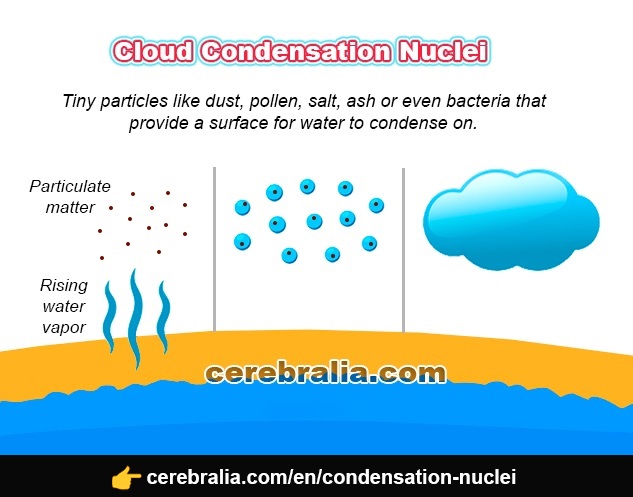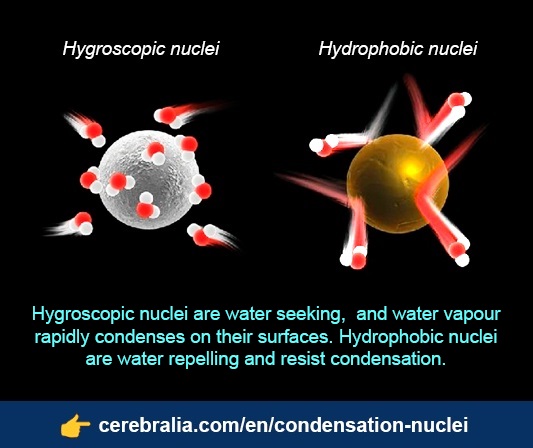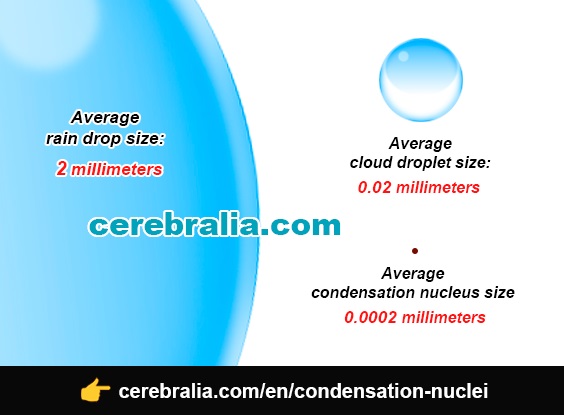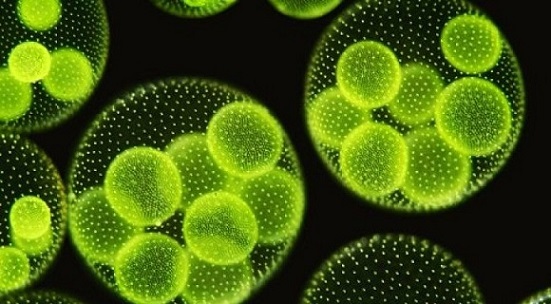Share on:
Cloud condensation nuclei
Cloud condensation nuclei (CCN), also known as cloud seeds, are small particles on which water vapor condenses. Water requires a non-gaseous surface to make the transition from a vapor to a liquid. This process is called condensation.
It is much easier for water vapor to condense onto theses particles rather than just condensing and forming small droplets of pure water. It's hard for water vapor to condense and form a small droplet of water because small droplets evaporate at a very high rate.

By condensing onto a particle, the water droplet starts out large enough and with an evaporation rate low enough that it is in equilibrium with the moist surroundings (equal rates of condensation and evaporation).
Particles in the air, cloud condensation nuclei (CCN), make it much easier for cloud droplets to form. There are always lots of CCN (cloud condensation nuclei in the air) so this isn't an impediment to cloud formation.
Types of condensation nuclei
There are many different types of atmospheric particulates that can act as CCN. The particles may be composed of dust or clay, soot or black carbon from grassland or forest fires, sea salt from ocean wave spray, soot from factory smokestacks or internal combustion engines, sulfate from volcanic activity, phytoplankton or the oxidation of sulfur dioxide and secondary organic matter formed by the oxidation of volatile organic compounds.

Because nuclei are made from different materials, they also differ in terms of their ability to form clouds (or fog). For example, something like sea salt can absorb water very well, thus forming droplets easily. However materials like soot from a coal fired stove or dust from the highway don't absorb water well and would have more difficulty producing a cloud droplet.
Size of condensation nuclei
A typical raindrop is about 2 mm in diameter, a typical cloud droplet is on the order of 0.02 mm, and a typical cloud condensation nucleus (aerosol) is on the order of 0.0002 mm or 0.2 µm or greater in diameter.

The number of cloud condensation nuclei in the air can be measured and ranges between around 100 to 1000 per cubic centimetre. The total mass of CCNs injected into the atmosphere has been estimated at 2x1012 kg over a year's time.
The concept of CCN is used in cloud seeding, which tries to encourage rainfall by seeding the air with condensation nuclei. It has further been suggested that creating such nuclei could be used for marine cloud brightening, a climate engineering technique.
Phytoplankton role
Sulfate aerosol (SO42− and methanesulfonic acid droplets) act as Cloud Condensation Nuclei (CCN). These sulfate aerosols form partly from the dimethyl sulfide (DMS) produced by phytoplankton in the open ocean. Large algal blooms in ocean surface waters occur in a wide range of latitudes and contribute considerable DMS into the atmosphere to act as nuclei.

The idea that an increase in global temperature would also increase phytoplankton activity and therefore CCN numbers was seen as a possible natural phenomenon that would counteract climate change. An increase of phytoplankton has been observed by scientists in certain areas but the causes are unclear.
